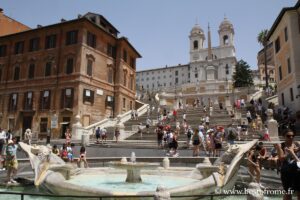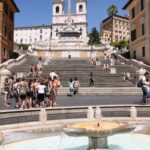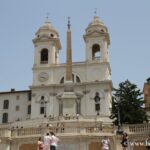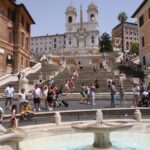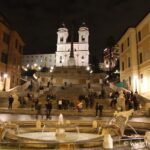In Italian: Piazza di Spagna
The Spanish Square (Piazza di Spagna) is one of the most beautiful and original squares in Rome, famous for its Baroque architecture and unique charm. Located in an upscale neighborhood at the heart of the Eternal City, it is dominated by the monumental Spanish Steps, which connect the splendid Barcaccia Fountain, a work by the Bernini family, to the French church of Trinità dei Monti, preceded by an Egyptian obelisk. This iconic spot, surrounded by luxurious streets like Via Condotti, attracts millions of visitors each year for its timeless allure and views over Rome.
The visit to the Spanish Square in Rome ranks number 7 on our Top 30 things to see in Rome.
Visiting the Spanish Square in Rome
A square leading to the Pincio
A work of the 18th century located at the foot of the Pincio hill, the Spanish Square has an unusual and irregular layout. The steps of the monumental staircase lead to the 16th-century French church of Trinità dei Monti, notable for its two symmetrical bell towers, in front of which stands an Egyptian obelisk from the Gardens of Sallust, placed here in 1789. Next to it, at the top of the steps, visitors can enjoy a beautiful view of the city.
Near the church lie the charming gardens of the Villa Medici, now home to the French Academy in Rome, designed in 1570 by Ammannati.
The Fountain and the Spanish Steps
At the base of the steps lies the Barcaccia Fountain (fountain of the boat), created in 1629 by Pietro Bernini and his more famous son, Gian Lorenzo Bernini. It was built to commemorate the disastrous Tiber flood of 1598, which forced residents to move by boat.
The staircase, in late Baroque style, features 136 steps. Designed by Francesco De Sanctis at the initiative of a French cardinal, it was inaugurated for the 1725 Jubilee. Made of marble, it spans three levels with terraces that bloom beautifully from spring onward. Approaching it reveals various perspectives of the monument.
Palaces and monuments around the square
To the right of the steps, the former home of English poet John Keats, the Casina Rossa, is now a museum. On the left stands Rome’s oldest tea room, Babington’s, founded in 1893.
Toward Via Frattina, the Palazzo di Propaganda Fide (Palace of the Propagation of the Faith) is a Holy See property, constructed starting in 1644. Its main façade was designed by Bernini, while the side façade was crafted by Borromini.
Opposite it rises the Column of the Immaculate Conception, inaugurated on December 8, 1857. Since 1923, on the Feast of the Immaculate Conception each December 8, Roman firefighters place a wreath of flowers atop the statue of Mary. The Pope attends this event, which has become one of Rome’s most popular religious celebrations.
The Spanish Square neighborhood
The streets of this district are among Rome’s most elegant, such as Via Condotti with its luxury boutiques like Prada and Gucci. On the way to Piazza del Popolo, Via Margutta is a characteristic Roman street known for its art galleries and artists’ studios.
Photo gallery: Spanish Square and Steps
- Spanish Steps
- The square, the stairs and the fountain
- Trinità dei Monti
- The square, the stairs and the fountain
- night view
Selection of accommodations near the Spanish Square
A selection of hotels, rooms, and apartments near the Spanish Square, sorted by price and distance
- Good hotels and accommodations sorted BY PRICE within 600 meters of the Spanish Square
- Good hotels and accommodations sorted BY DISTANCE from
the Spanish Square
Suggested tours and excursions
Suggested tours and excursions (currently in English) including the Spanish Square, the neighborhood, and other iconic Rome landmarks
Information and map
Resources for further exploration
- The Spanish Steps on Rome-roma, photos, history, and architecture
- On Wikipedia: Piazza di Spagna
- Official city site: www.turismoroma.it
Map and how to reach the Spanish Square
You can reach the Spanish Square, among other ways, via the “Spagna” metro station (Line A), just a few steps away. On foot, it’s quite close to the Trevi Fountain or Piazza del Popolo.
If you see this after your page is loaded completely, leafletJS files are missing.
FAQ and tips for visiting
When to see the Spanish Steps in bloom?
It’s in spring, between April and May, that the terraces of the steps are adorned with blooming azaleas.
What to priorate at the Spanish Steps?
- The Spanish Steps: the 136 steps, panoramic view, decorated in spring
- Barcaccia Fountain: shaped like a stranded boat, a Bernini work
- Column of the Immaculate Conception: religious monument, with a ceremony on December 8
- Other buildings: Trinità dei Monti Church, façades of palaces by Bernini and Borromini
What to see around the Spanish Square?
In the immediate vicinity of the Spanish Square are the Column of the Immaculate Conception, the Casina Rossa (Keats-Shelley Museum), Babington’s tea room, and the upscale district with luxury shops like Via Condotti (Prada, Gucci).
At the top of the steps is the Villa Medici with its stunning gardens, and a bit further, the park and viewpoint of the Pincio (original links kept as English versions unconfirmed).
The Trevi Fountain is less than 10 minutes away on foot, as is Piazza del Popolo (original links kept as English versions unconfirmed). Heading toward the latter, the charming Via Margutta stands out with its artisans.
On the other side, Piazza Barberini and Via Veneto are also within a 10-minute walk.
Which guided tours include the Spanish Square?
Many Rome tours include the Spanish Square, often paired with the Trevi Fountain, the Pantheon, or Piazza del Popolo. Check our “Suggested tours and excursions” for tour ideas in English or other languages (original link kept as English version unconfirmed).









